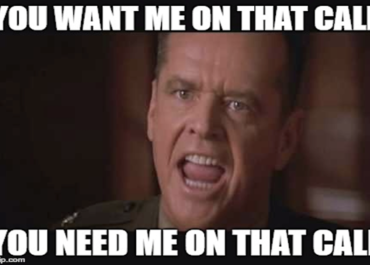
Understanding the Situation with AI
We are quickly approaching 2023 Joint Business Planning meetings with our retailers. I hope your meetings don’t turn out like this hilarious CPG sales rep voice over of this famous scene from Few Good Men (Link Attached). To hopefully avoid these types of arguments, I’ve used a tool called the Conceptual Selling Framework.
I’m a raving fan, trainer, advocate, cheerleader of the conceptual selling process. First introduced to me during my days at Red Bull, I’ve likely trained, preached and used this framework hundreds of times over the last 10 years. I use it internally, with customers, even during HOA meetings. If you are a Buyer, the same framework can be used to convince your Sales Rep to “buy into” the platinum sponsorship for your company golf outing. If you pay attention, you will see every presentation on shark tank follows this framework. Although the framework appears to be simple, it still takes a ton of practice to master.
Let Me Explain
The conceptual selling framework consists of 5 parts:
Summarize the situation
State the idea
Explain how it works
Reinforce key benefits
Easy next steps
The most visible impact of using this framework is a presentation that gets reduced to 8-10 slides (or “boards” if you work for Altria). I once took an 80 page category review and reduced it to 11 slides! Blew the Buyer’s mind (having sat through the 80 slide presentation in the past) and scheduled recurring meetings for the balance of the year to listen to our perspective.

Understanding the situation?
The hardest part of this framework is accurately assessing the situation you are trying to explain. The presenter should invest 50% of their time explaining the current situation that impacts the audience. The objective of “explaining the situation” is to identify and lay out the problems that the audience may not have considered. By using data, observations, and knowledge, the presenter is seeking to garner alignment with the audience on the problems that need to be solved to improve the current situation. Your idea then solves this problem.
What Are We Trying to Solve?
Failure to credibly outline the situation is the most common mistake I see with presentations. Either the presenter has rushed through the situation, eliminated it altogether, or not provided credible data that convinces the audience that they understand the problem. So often, I find myself during prep sessions asking, “So what are we trying to solve here?”. That generally means that the presenter has not laid out the situation properly.
I Can See Clearly Now That the Rain is Gone
One problem I see people have with explaining the situation is lack of a complete picture. We will often take cross-sections of data, or small sample sizes thinking that this reflects the accurate picture of what’s happening. I work in the CPG retail world, and ideas fail to launch because they don’t have the complete picture. Or, they have so much data from multiple sources that they actually say nothing (can you say 80 page deck). Said differently, we can say nothing with too little and too much data. What are we trying to solve?

Complete Picture, Focusing on What Matters Most
One area of the CPG world where both too little and too much data tends to mean nothing is store-level retail execution data. Arguably the most important piece of data needed to explain the situation, manual audits provide too little or even inaccurate data as those performing the audit and those putting the data together can only reach so many stores. If questions are involved, inherent bias from each auditor gives inconsistent answers. If pictures are involved, no one has the time to review thousands of pictures. “That will be good enough” after 10-20 pictures are reviewed.
This is where tools like PIC2POG and Store360 from Maxerience can help deliver actionable insights from the entire data set. You can get an assessment of every store, not a cross section, and roll up into a report that helps report the data in a simple concise way filtered by the most important gaps in the category.
When explaining a situation, it’s no longer acceptable to use limited data. The risk to credibility and poor recommendations is simply too great. Invest in seeing the entire picture of your situation.
Your idea is only as good as the problems you solve.
For more information on AI- Image Recognition, visit maxerience.com or contact Jason DeRienzo at Jason.derienzo@maxerience.com.

